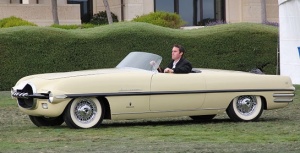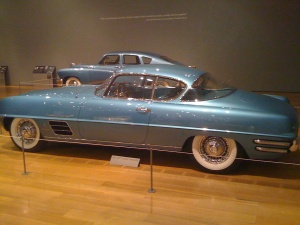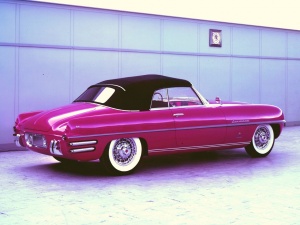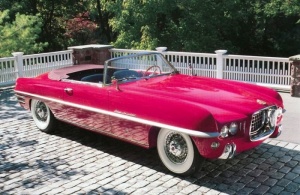1953-54 Dodge Firearrow (Concept Car)
.
Fire arrows are an early form of gunpowder solid fuel rocket which were attached to a shaft of the arrow to provide a propulsive force. The Chinese are credited with both the invention of the fire arrow and also the first use of fire arrows in a military warfare.
However since this is the MoparWiki, the name Fire Arrow was applied to four Dodges in Virgil Exner had commissioned as Dream Cars in1953 and 1954. There were designed to be Chrysler's version of the Chevrolet Corvette, and Ford Thunderbird. The Firearrows followed a logical progression from dream car to producible vehicle.
Contents
Fire Arrow I
The first one-which we ought only to count as one-half-was a "buck" on a Dodge chassis. It didn't run and was really only one step up from a full-size clay model. Establishing a proportion Exner strove for, this 1953 Firearrow I was more than twice as wide as its body height at the cowl. "The body itself is flat and broad with only a slight crown, or slope, in its top and side surfaces," said a contemporary description. "Stylists have a word for this . . . they call it 'tautness': the metal between any two points seems stretched to fill the space smoothly, with no wasted contour, rather than appearing full-blown or overly curvaceous." It was the diametric opposite of typical mid-Fifties design.
Certain themes showed cross-pollination -- everyone in Detroit knew each other and ideas got around. For example, the concept of a massive bumper/grille, flowing around at the sides, may have originated at the Kaiser-Frazer studios in the late 1940s, while the Firearrow's chrome exterior tailpipes were seen in almost the same place on Frank Spring's Hudson Italia, the first of which was built in mid-1953. On the latter they merely housed taillights; on the Firearrow they were fully functional.
The full-perimeter bumper was painted metallic gray rather than chromed; the car itself was red metallic, with a yellow-buff leather interior piped in maroon. This model also had quad headlamps, possibly their first appearance on a show car. (They first appeared in production on the 1957 Nash and Cadillac Eldorado Brougham.)
Fire Arrow II
Next in line was the 1954 Firearrow II, another roadster, but modified in detail. Mounted on a stock 119-inch Dodge Royal wheelbase, it was powered by a 250-horsepower Royal V-8 with Gyro-Torque Drive (Chrysler's famed M-6 Fluid Drive with torque converter). While its basic shape was unchanged from the Firearrow I, the quad headlights had disappeared, replaced by single lamps faired into pods at the front end, breaking up the full-perimeter bumper. The grille and taillights were restyled and there were two rear deck hatches: one to hold luggage, another for the spare tire and fuel filler. Each was counter-balanced and spring-loaded to pop open when levers were pulled inside the driver's door. Other features attested to the Firearrow II's pure experimental nature: There were no door handles, no rearview mirrors, no side windows, no top. Doors were opened by pressing a flat metal release bar at the top inner molding or, from the inside, by pulling a knob that extended into the painted armrest support.
The Firearrow II was painted pale yellow with a black central bar through the grille (similar to the 1953 Plymouth grille bar) and black bodyside molding; black leather adorned the interior. The doors were similarly upholstered, and because of their deep curves they allowed generous armrests, which gave "a pronounced recessed effect to the cockpit sides," according to Chrysler. The dash contained full instrumentation, including tachometer, plus toggle lever controls and an aluminum-spoked steering wheel with a wooden rim.
One novel feature of the dummy roadster was carried over to Firearrow II: a huge, one-piece, glass windshield. But whereas the mock-up's windshield had a thin frame and was carried in a grooved metal base affixed to the cowl, Firearrow II's was sunk into a deep "slot." The glass you saw was only the tip of this glacial mass: There were 14 inches showing above the cowl and 24 inches sunk into the slot! Unlike the mock-up, the Mark II's glass was tempered, but owner Joe Bortz is wary of taking chances with it: "It's crystal, and very fragile. We've made a foam slipcover for it and a metal cage to protect it when traveling. The restoration man wanted to make a plexiglas copy but I was afraid he'd break the original in the process -- and once gone, it would be gone for good."
Fire Arrow III
Firearrow III sported a huge, new grille cavity with concave vertical bars, flanked by quad headlamps. Though the chassis/drivetrain was initially stock Dodge, the coupe body aided streamlining. After engine modifications, Betty Skelton took the Mark III around Chrysler's new Chelsea, Michigan, banked test track at 143.44 mph, setting a new ladies' closed-course world speed record.
Fire Arrow IV
Last of the Firearrows was a late 1954 convertible, another practical car with roll-up windows, trunk, and conventional door handles; it also had a functional soft top. "I think we could have built that," Maury Baldwin, an Exner colleague who himself designed the 1955 Plymouth. "But management at that point was very stodgy. A lot of people attributed it to the old Airflow disaster. They were afraid to make any new inroads." Flashiest of the series, Firearrow IV had a bold quilted black and white diamond-pattern leather interior; the front seats reclined, while the rears could be lifted out, revealing a mahogany luggage platform with chrome skid strips. Painted bright red, it was probably the most significant of the series, because it influenced a limited-production car, the 1956-1958 Dual-Ghia (of which 177 were reportedly built). There are no interchangeable panels between the two.
This Wiki is Under Construction, and can use your help!
Please take a moment to add any information you might have on this topic. It is through this type of Member collaboration that the MoparWiki will grow into being the Ultimate Mopar Infobase. The links contained in the Understanding Wikis box in the sidebar can help you get started.
References
Books & Magazine Review
Internet
Random Page | Longest Wikis | Oldest Wikis | Newest Images | Newest Wikis | List of Categories | List of Every Freakin Wiki
- Register to Edit
- It takes less than 5 minutes to request registration for editing, and we try to approve within 24 hours. Click the Register Link in the Top Bar.
- MoparWiki Help
- While editing Wikis may at first glance appear a little overwhelming, it really isn't. You will find this site's HELP (link found in the sidebar) to be very strong and easy to understand. The best way to start is with small edits and working on your user page -- and you will become a Pro in no time.




